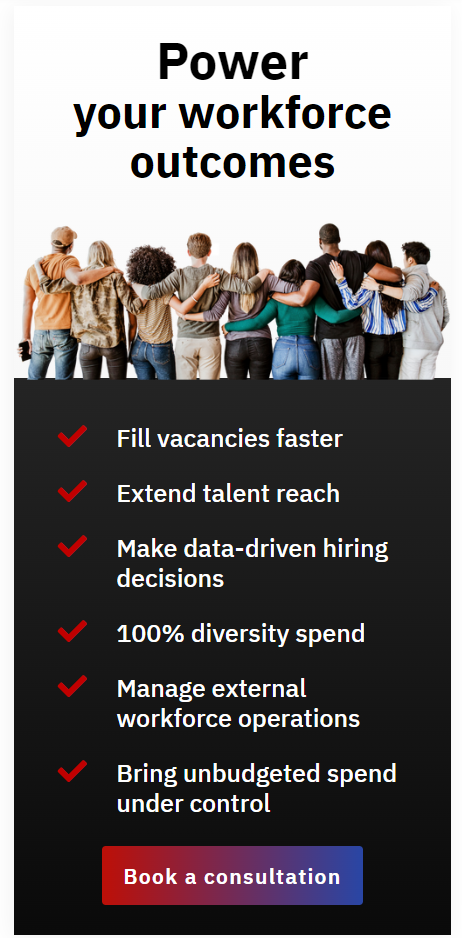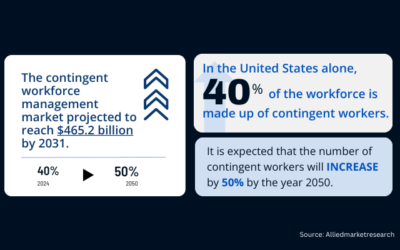Jake Ellis - 5 min read
MSP Analytics: Driving Insights for Smarter Contingent Workforce Decisions
Top talent has never been more in demand, but traditional methods of sourcing highly skilled workers aren’t working. Competition is fierce, and your organization is vulnerable to a shortfall in qualified workers if you rely on outdated hiring strategies. The impending talent crisis poses a real threat to your business success. A talent crisis doesn’t have to be your future. This article will equip you with the data-driven strategies you need to build a resilient and high-performing contingent workforce in a market plagued by skills shortages and competition.
Building Blocks of a Data-Driven Contingent Workforce Strategy
A data-driven workforce strategy is your solution. Data analytics gives you an undeniable competitive edge. Imagine the power of predicting your exact talent needs, both short-term and long-term. This clarity guides you towards the most effective sourcing channels, ensuring you attract and hire the best talent for every role. Moreover, data-driven insights empower you to refine how you manage your team. These insights drive engagement and maximize retention.
A data-driven strategy starts with a laser-sharp understanding of your current and future talent needs. This is where data analytics is essential, allowing you to analyze historical hiring patterns, current skillsets, project forecasts, and even shifts in competitor talent strategies. This comprehensive view reveals your exact needs, preventing costly misalignments between your contingent workforce and strategic goals.

A study by McKinsey found that companies with strong talent analytics see an 80% increase in the efficiency of their talent recruitment processes.
Defining and Anticipating Talent Needs
To stay ahead of the curve, you need predictive analytics. Pinpoint future talent gaps, allowing you to source talent, develop in-house solutions, or adjust project plans. For example, imagine your data shows a future need for a specialized skill. With this insight, you could begin looking for the right external talent before the need becomes urgent. Prioritize collecting data on existing skills deficits, shifting project requirements, and your competitors’ strategies for the most comprehensive and actionable insights.
Evaluating Supply Chain Capability
Scrutinize your supply chain’s capability to source the talent you need consistently. Assess its speed, agility, and specialization. Can it deliver talent with niche skills quickly enough to meet project deadlines? A data-driven analysis uncovers bottlenecks, strengths, and untapped potential, that may reveal the need for new supplier relationships or specialization within your supply chain.
Optimizing Talent Management
Once talent is on board, prioritize efficiency. Track the performance, skill utilization, and engagement levels of sourced talent throughout project lifecycles and beyond. Are valuable skills being underutilized? Are high-performers feeling unchallenged? This data informs project-level adjustments and long-term improvements to your talent management strategies, maximizing the value of your workforce. Understanding what drives retention is also vital. Use data-driven insights to determine what motivates high-performers, enabling you to tailor retention strategies and prevent the costly loss of top talent.
Cost Optimization Strategies
Use data-driven benchmarking to compare your resourcing costs to industry standards. Could exploring alternative sourcing channels or renegotiating supplier agreements yield significant savings? Remember, low costs don’t mean value unless they also deliver the talent you need.
Prioritizing Compliance and Risk Mitigation
Finally, prioritize compliance and risk mitigation. Regularly ensure your talent sourcing and management practices align perfectly with all relevant regulations and industry standards. Failing to do so risks fines, penalties, and damage to your company’s reputation. Conduct thorough, data-driven risk assessments to identify vulnerabilities, focusing on onboarding processes, data privacy, and background checks.

Gartner predict that by 2025, 70% of procurement organizations will use advanced analytics to mitigate supply chain risk.
Common Data Challenges
Even with the best intentions, building a data-driven strategy has its challenges. Many procurement leaders grapple with inefficient data collection and organization systems. The lack of a streamlined approach severely hampers in-depth analysis and the ability to derive truly meaningful comparisons.
Data becomes less valuable when it’s locked in silos. Critical context often exists within individuals’ experiences and their understanding of intricate organizational dynamics rather than in centralized databases. This loss of context dramatically diminishes the impact and actionable insights your data could offer.
Further complications arise from fragmented systems. Even when your organization captures data, it frequently resides in disparate, unconnected systems – hindering a holistic view of talent or projects. The lack of common identifiers and links across these systems makes it virtually impossible to consolidate the data in a way that supports comprehensive analysis.
Breaking Down the Data Silos
The good news is that these challenges are not insurmountable. Implementing a data-driven workforce strategy, underpinned by a holistic data strategy approach, empowers you to leverage the power of data analytics to overcome them. Here’s where an insights platform comes into play.
A cloud data hub platform—like Workspend WRAP—facilitates a centralized data repository accessible across departments, ensuring consistent data collection and eliminating information silos. Platforms, such as WRAP, streamline data management by standardizing data formats and establishing common identifiers, allowing for seamless data integration from various sources, including legacy systems and even individual experiences captured through surveys or feedback forms. This centralized, unified data empowers in-depth talent analytics, unlocking actionable insights for strategic workforce decisions.
Change the way you improve
You can improve your strategy by either doing things better or doing better things. Process optimization focuses on refining existing methods for marginal gains. In contrast, true transformation boldly reimagines how to approach the work itself, potentially delivering substantial leaps in productivity and impact.
Most data-driven initiatives within procurement tend to focus on efficiency gains within existing processes. True transformation challenges the status quo. Could direct sourcing models change your fundamental approach to talent acquisition? Could AI-powered tools displace or automate significant portions of your current workload?
Be proactive not reactive
A federated data and governance system is required if you want to make truly informed decisions. This system consolidates and centralizes data from all your critical sources. A well-designed system shouldn’t just provide insights; it should be predictive. Anticipating risks, potential opportunities, and upcoming talent needs will transform procurement from reactive to proactive. This ability to see around corners is the key to building a resilient, future-proof contingent workforce.
Next Steps for Smarter Contingent Workforce Decisions
Choosing the right external talent partner and platform to integrate it into your workflow is essential to unleashing the true power of your data.
If you’re new to managed contingent workforce programs, a thorough program assessment is the essential first step. This assessment will establish a baseline of your current practices and data capabilities, highlighting areas for improvement and strategic development.
Even organizations with existing programs often underutilize the power of advanced analytics. Traditional MSPs rarely provide the cutting-edge tools needed for deep insights. Workspend’s discovery assessment is a powerful tool for benchmarking your current program and identifying its full potential. This customized approach pinpoints gaps limiting performance and unveils the hidden opportunities that a data-driven strategy can unlock.
Wherever you are in your workforce journey, we can help you find and implement the data solution that is right for you.
You may also like:
Finding the Right Fit
Find out how generative AI can be employed to streamline the process of finding the best fit candidate for your organization.
AI Should Augment Human Intelligence, Not Replace It
Will smart machines replace human workers? How human intelligence can work with artificial intelligence to produce augmented intelligence.
Reducing Contingent Labor Costs: Strategies for Maximizing Efficiency
Discover how Workspend can help you reduce contingent labor costs and boost efficiency. Gain insights, implement strategic sourcing, optimize workforce planning, and ensure compliance. Partner with us for streamlined solutions. Contact us today!




